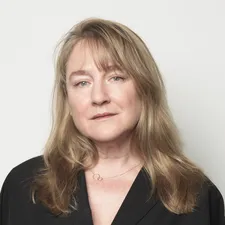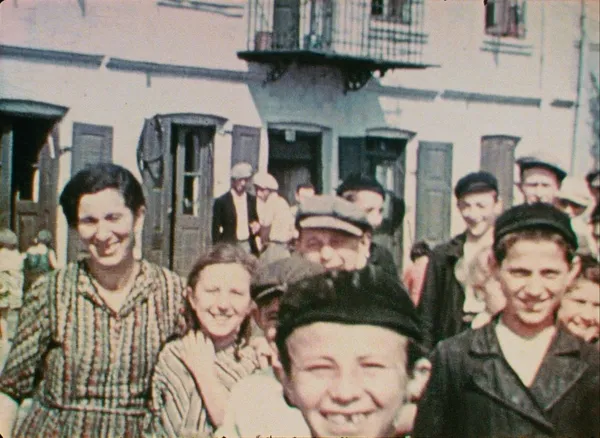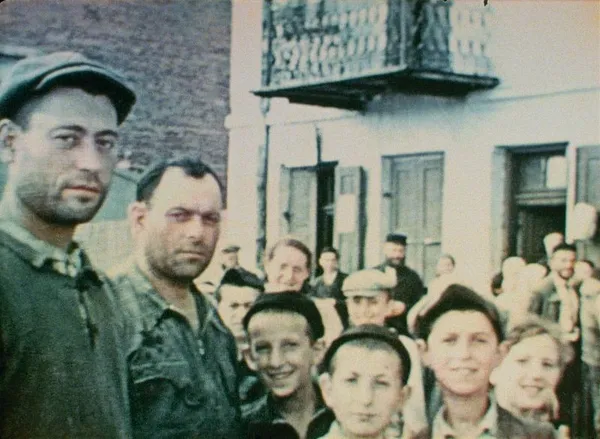Historian, critic, journalist and producer Bianca Stigter (Widows, 12 Years A Slave) turns her hand to documentary in Three Minutes: A Lengthening. The film takes a rare piece of, mostly colour, footage shot in the Polish town of Nasielsk in 1938 – a community which included 3000 Jewish residents, all but 100 of whom would be murdered just years later in the Holocaust. Stigter’s essay film, narrated by Helena Bonham Carter, plays the film back and forth, zooming in on detail and biography, offering a tribute to the townsfolk, while also providing a rumination on the importance of historical footage like this to the present day. I caught up with Stigter shortly after the film screened at Sundance to chat to her about it.
Amber Wilkinson: You’ve said you first came across his story on Facebook. After you first spoke to Glenn Kurtz, who wrote a book Three Minutes In Poland: Discovering A Lost World In A 1938 Family Film about this footage, how did you go forward from there? Did you do detective work in tandem or did you pick the baton up from him and run with this story in your own direction at that point?
Bianca Stigter: First saw the footage and had the idea – and the idea was possible for a big part, because Glenn’s book was there. So there was a lot of research already done. And in fact, there's much more information in the book than I could possibly put in the movie. And while we're at it, of course, I did some more – you never stop researching. So I did some more research while we were making the movie.
AW: I was wondering about the shape of the film if you were still sort of doing research. Did that mean you had to be quite flexible in the in the way that the film was developing?
BS: I worked on it for more than five years. It developed organically, let's say, so when we went to, for instance, Detroit to record a conversation with one of the survivors in the film, Mr Chandler, who is visible in the film as a 13-year-old boy. Then we had that, of course, and we went to Nasielsk to hear what it sounded like now, I went to Treblinka, where most of the people from Nasielk were murdered, and I spoke with a Polish historian and a Polish researcher so, bit by bit, we could build it up.
AW: When you're doing an essay film, you must have to be sort of quite confident in yourself, because it's a lot of working alone. Did you did you find that maybe because you had a background in film criticism, which is kind of another lone kind of working environment, that it helped?
 |
| Bianca Stigter: 'I’m always looking for a way to present history which is a bit different' Photo: Annaleen Louwes |
BS: Maybe, I'm not sure. Well, of course, you've seen a lot of films that that helps, and I was very interested in this subject. I'm a historian by trade. So while I was working on this film, at the same time, I was making a big book about the history of Amsterdam, The Occupied City. I’m always looking for a way to present history which is a bit different than just –you know, I love books – but a book just tells one story with a beginning a middle and an end. But at the same time, working as a writer, I also like to say journalism, writing essays, that also helped me as well, because a story has to have a certain rhythm and that kind of thing. It’s a time-based art and it all works a little bit the same except now you have more tools.
AW: Film is a much more immersive environment. There is something very emotionally immediate about the combination that you managed to achieve, that sort of sweet spot of the sound and visuals which you can't do with any other medium, really.
BS: For me, that footage felt like a kind of magic, and for me, it was very important that it was in colour, because we are used to seeing this world where everything basically before 1945 or 1950, is in black and white. If you think about movies from the time or newspapers or magazines, most of it was in black and white. So to see something authentic from 1938 that was colour brought it back to me much more and gave it a kind of immediacy, as if the film wasn't that long ago.
AW: For me, the immediacy of it was that real sense of life that's in the film, of everyday life just happening right there. When you have in your mind, obviously, that this was about to come to this awful screeching halt.
BS: People are laughing and playing, and these kids, they really want to be seen, not necessarily by us, but they want to be seen. And then, of course, there's knowledge that we have and that they don't have puts these images on a lot of almost unbearable pressure.
AW: How was working with Maurice Chandler with that? In a way, he must have felt a pressure in a sense that, here he was the eyewitness - although he doesn't remember it, which is interesting in it in itself. I know you can't speak for him personally. But I was thinking when you were working with him, he must have been feeling some pressure about you know, being able to remember things for you.
BS: I suppose, yes. He and his family couldn't be more kind and helpful, also his wife and his daughter and granddaughter and all the rest. So it was a beautiful experience, but you can see that it's a hard subject to talk about. But at the same time, when he saw these images for the first time, he said to Glenn, “You've given me back my childhood”, because that world doesn't exist any more. And because it was so fast, there's hardly anything left of it.
A lot of people don't have a photo album to say, “Look, this is what it was like before the war”. So for him to be able to share something outside of his own memory as a kind of proof, like, “Look, this was the world I grew up in”, this was the street, his house was right opposite what we see in the in the movie, so that he said to his children, “Now you see I'm not from Mars, this was really a specific place in a specific time”.
AW: There was more than one film at Sundance this year that really brought home that importance knowing your heritage, being able to connect with a very specific point. You have something tangible. It's like something really physical to connect with. I feel like you were trying to get the audience to connect with that idea of film at that time as well, the presence of and the way that film works, from the sound design on upwards - we hear that crank to start. So you kind of putting us in that space. Was that something that was really important to you as well?
BS: Absolutely. Yeah. I see it more as a kind of essay film as well, where you can ponder all these kind of questions. What is film and how does memory work? Or if this is a memory, and all the people that could remember the same thing are not alive any more does that change the status of such a movie? And all those kind of questions were very interesting for me in the documentary. You do not have to give all the answers but you can, let's say, pose the questions and that was very interesting for me to work around.
AW: When do you know when to stop, because you're uncovering all these different elements, but you need to be selective in some way. You have to stop digging at some point.
BS: At the beginning of the movie, when it's kind of established that it's not hard to, to find where it was and then hard to find who are the people we see in the in the film. I also said, “Okay, now we're going to research the other things we can see. What are the dresses they wear? Can we say something about that? And what can we say about the plants?” For instance, on the window sill of this kind of restaurant place there’s a plant, and the production people asked billions of botanists, what is this plant? Is it this? Is it that? and no one could give the answer because the image was not sharp enough for anyone to be really confident. With the linden trees, we got there in the end. So there was a lot of to say. Also, there was, for me, an interesting point, how far can you go , can you know everything that you see? Or does that also gets boring at certain point? Because how interested are other people in knowing what this flower is or what kind of bird or all that kind of business? So these were the things that you have to play with and put them in the right doses and at the same time showed a little bit of the frustration that you cannot find the really important things, namely, who were these people?
AW: Do you think do you think it changes your perspective as a producer though having directed now yourself? Do you think it's changed how you will produce going forward?
BS: Probably not. For this one, I was kind of amazed that I always knew what I wanted. This is how I wanted it to be and what I would like to make. It was interesting for me that this first nucleus of the idea kept being the motor for five years.
The film will be released in US cinemas this spring























